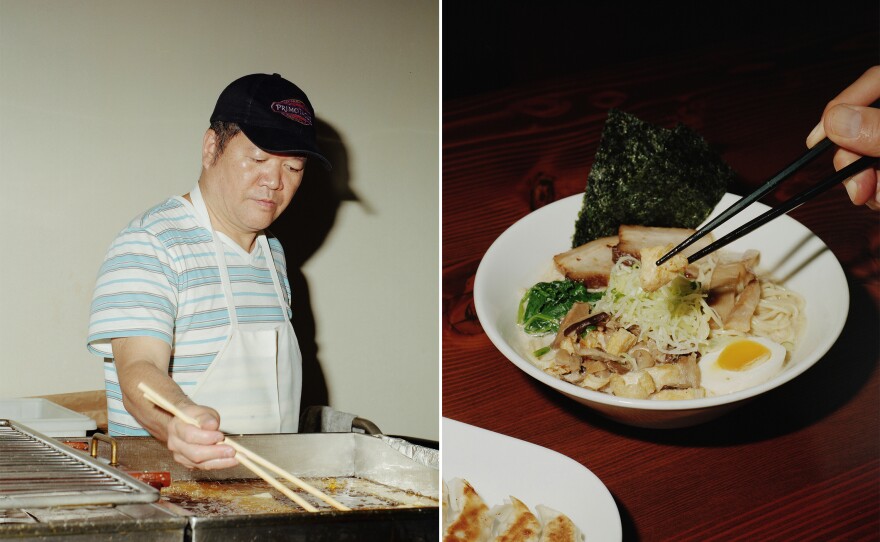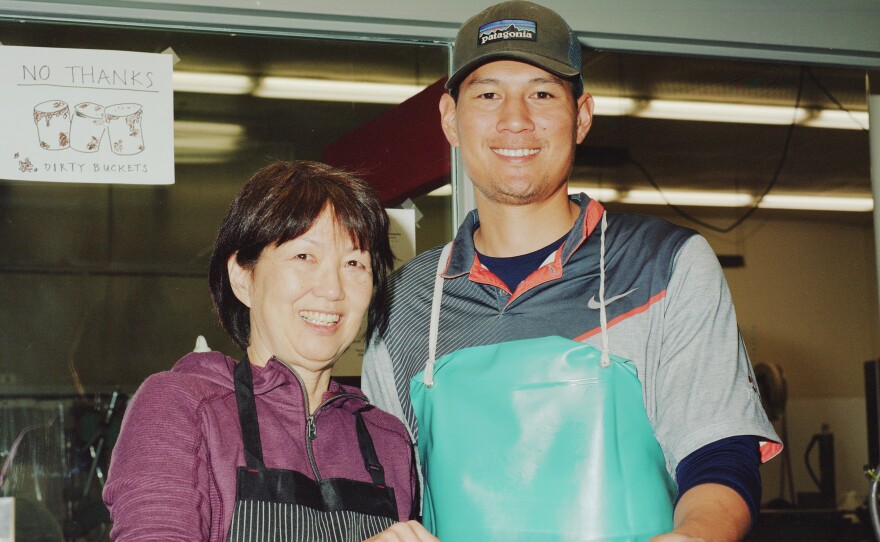Growing up in Portland, Ore., in the '90s, tofu could be hard to find. It would be a long time before ramen joints spread across the city, before national chains like Trader Joe's and Whole Foods had their own store-brand tofu.
But like soba noodles, nori, rice and fish, tofu is a staple of Japanese home cooking. So my parents regularly made a 15-minute drive east, across the Willamette River, to stock up at Ota Tofu.
The old-school company still makes its tofu by hand in small batches, navigating a growing demand for plant-based foods. But what I didn't realize then is that it's also a cultural institution — the oldest tofu producer still operating in the country, Ota Tofu has fed Portland's Japanese American community for more than 100 years.

Eileen Ota, a former owner of Ota Tofu, notes that other tofu producers existed earlier in the United States, but many ceased operations because of one event: the internment of Japanese Americans during World War II.
President Franklin D. Roosevelt's executive order gave an estimated 120,000 Japanese Americans only a few days to pack up their belongings for indefinite incarceration. That forced many small-business owners to liquidate their inventory and equipment, and farmers had to sell their land for fractions of its worth. The economic losses at the time were between $1 billion and $3 billion ($16 billion to $47 billion in today's dollars), according to Densho, a nonprofit dedicated to preserving the history of the internment.
Shina and Saizo Ohta, the co-owners of Ota Tofu at the time (Ohta is the original English spelling of the family name), were forced to leave Portland for the Minidoka Relocation Center in Idaho. They left their shop without any guarantee they would be able reopen it.

Saizo Ohta, who was 61 when they left, died at Minidoka, according to Eileen Ota, who brought a thick binder of historical documents and printed emails when we met for coffee. When the landlord of the shop heard about Saizo's death, she decided to keep their equipment and property for Shina, Saizo's wife. When she returned, she reopened the shop on her own, and it stayed in the family until Eileen Ota sold it in February.
I grew up on Ota's tofu, most of it prepared as hiyayakko — cold slices resting in an umami bath of soy sauce, ginger and scallion, with some dried bonito flakes scattered on top if we had any.

I've probably eaten more tofu than any other protein, but I didn't know anything about how tofu was made. So on a predictably rainy morning in October, I came in to photograph the manufacturing process.
Steam wafted through the production room, and it smelled like soy milk and oil from making agedashi tofu, which is sliced thin and fried in-house.
Regulars lined up at a cluttered counter near the front door to pick up a block or two of fresh tofu wrapped in plastic bags. One customer brought his own plastic container.

Ko Ota, the only direct descendant of Shina and Saizo Ohta at the shop, comes in at 3 a.m. every day to oversee the cooking process. Ota Tofu's handmade product has become something of a rarity as demand for tofu has increased in the past decade — higher demand requires more output, so many manufacturers have switched to a fully automated process. "Our competitors essentially just push buttons," said Jason Ogata, the new owner of the company.

The Otas almost automated the process in the '80s. They bought a semi-automatic machine from Japan, installed it and made a few batches. Then they tasted it.
"Even though it was faster and easier, we decided to focus on the older, more labor-intensive method," Eileen Ota said. They put the machine back in storage, and it's still there under a pile of packaging.
Ogata told me that he'd been eating Ota Tofu his whole life and knew that he wanted to take over when the opportunity arose. The employees remain the same, as does the tofu they make, but Ogata did make a few operational updates, including creating a website, making an Instagram account and adding a computer at the front desk. "They used to write every invoice by hand," he said.
I chose to photograph Ota Tofu in medium format film to slow myself down, to look closely at the craftsmanship that goes into each block of tofu.

Before I left, Ogata's mother, Sharon, asked me what type of tofu I like. "Firm," I said, and she handed me two bags of fresh tofu before I could refuse.
That night I sliced it into hiyayakko, the same way I've had it since I was a kid. Jason and Eileen said it was their favorite way to eat it, too. It's a purist's approach; the tofu has to be good enough and fresh enough to handle it. Old tofu gets some funk, while mass produced tofu often tastes like a white cube of nothing — it's a vehicle for sauce. But when it's made on the same day, by hand, tofu is clean and mellow and smooth.
Stores like Ota Tofu do much more than make food: they are gathering places for communities, places to preserve culture and help you feel like you belong. Without it, I'm not sure I would've eaten as much Japanese food as I did. Its success is a reminder of what many other U.S. communities lost in the internment of Japanese Americans — and what they may be losing today as mass incarceration and detention continue.
Copyright 2023 NPR. To see more, visit https://www.npr.org. 9(MDAzMjM2NDYzMDEyMzc1Njk5NjAxNzY3OQ001))







